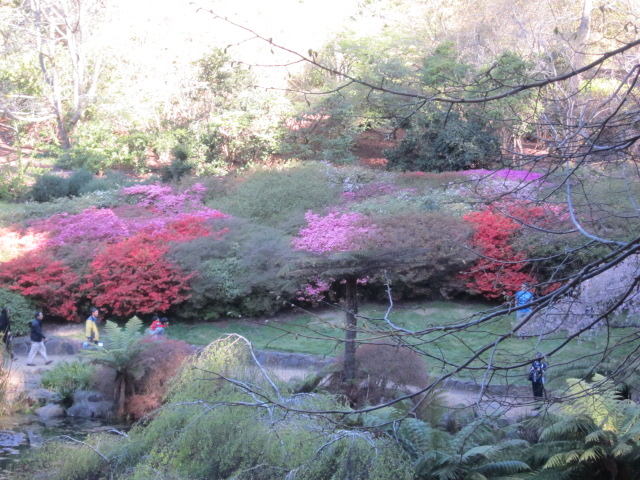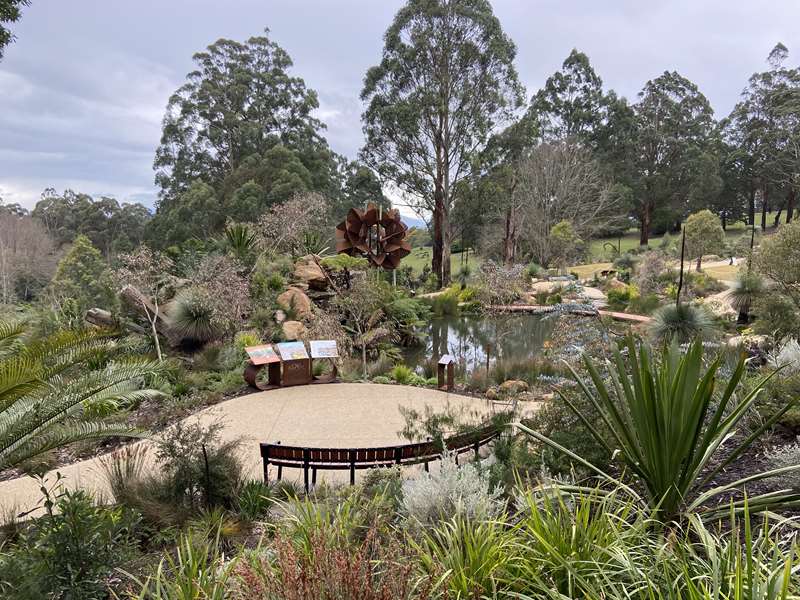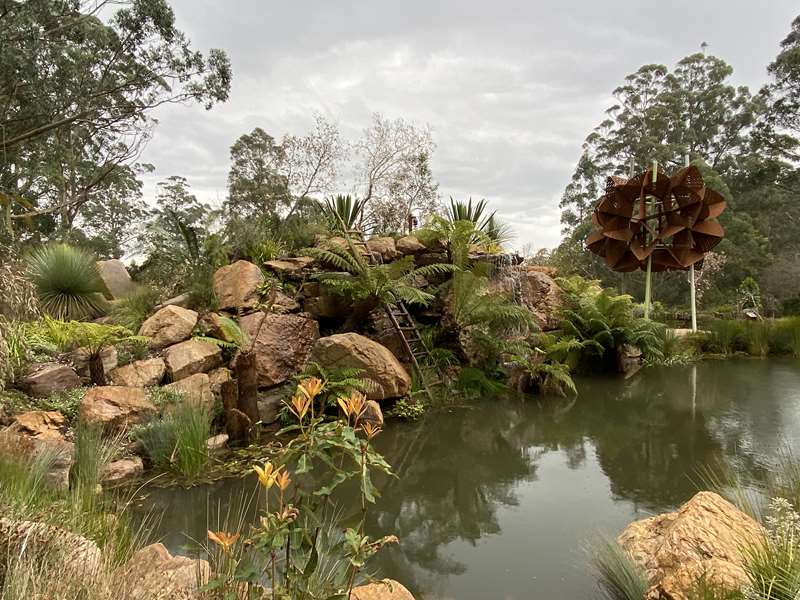Dandenong Ranges Botanic Garden (Olinda)


The Dandenong Ranges Botanic Garden which was formerly named the National Rhododendron Gardens, are host to brilliantly coloured blooms of rhododendrons, azaleas, camellias, cherries and daffodils. Seasonal changes ensure the gardens are a delight all year around.
The 42 hectare garden was first established by the Australian Rhododendron Society in 1960 for the display and propagation of rhododendrons in an Australian setting.
When not in bloom, you can still soak in the beauty of rich bark textures, seed capsules, foliage shapes and beautiful fragrance as you stroll through the grounds. There are wonderful views of the Yarra Valley and Great Dividing Range.
The gardens house Cafe Vileya which serves hot food, coffee, cakes, sandwiches, slices, Turkish rolls and gelato.
Garden tours run in a small bus (charges are applicable).
Opening Hours:
Open 10.00am to 5.00pm daily (last entry 4.30pm) except Christmas Day. The garden may close during dangerous weather conditions, high fire risk or for major works.
Cost:
Entry to the Gardens is free.
Things to Do and See
Whatever time of year you visit there is always something to see.
In early spring you can walk the golden mile of daffodils and see many of our camellias and magnolias in flower. By mid spring the Cherry Grove is in full flower. This time is also the peak season of flowering for the azaleas and rhododendrons and it is a pleasure to wander through the sprays of extravagant colour.
.jpg)
Summer is a great time to walk the nature trail in the cool rainforest atmosphere or picnic in the cool shade on the Cherry Lawn and wander through the collection of conifers. The brilliant blue and white hydrangeas can be seen in full flower with many large banks of them planted around the garden.
Autumn is ablaze with colour as the deciduous trees and shrubs turn every shade of yellow, red and orange. The views by the lake are spectacular as many of the hydrangeas take on rustic colours and are reflected in the cool calm waters.
Winter is a season of contrast. The mists create an aura of mystery amongst the Mountain Ash and the air is always fresh and cool. Bare tree trunks and branches reflect in the mountain lake and in late winter hellebore and cyclamen flowers carpet the ground. The vireya collection can be seen flowering at all times throughout the year.
History
The National Rhododendron Gardens was developed by the Australian Rhododendron Society when the State Government issued them a lease of land next to Olinda township in 1960. An enthusiastic team of people cleared land and started to plant around the southern end of the garden.
In 1962 a large bushflre bumt the area to the ground. While this destroyed much of the original plantings it also saved much work by clearing the bush for the garden.
Many of the early plantings were propagated by members of the Society from their own collections and from seed and plant material sent from other international and national rhododendron societies. Collectors from the society made trips to New Guinea, India and Nepal to collect some of the specimens which are in the gardens.
Access for Dogs:
No dogs, cats or pets.
Review:
The Gardens cover a huge area and it represents very nice walking opportunities with lots of distractions such as beautiful gardens and two ponds. Some of the area is very steep and make sure you are capable of ascending back up the hill before you start descending - we saw quite a lot of adults gasping for breath while getting back up the hill. There are some shaded seats beside the tracks and plenty of grassy areas for picnics. The The Chelsea Australian Garden at Olinda is a magnificent highlight (see below).
Photos:
The Chelsea Australian Garden at Olinda

The Chelsea Australian Garden at Olinda is a new feature garden that aim to showcase native and endangered plants, sustainable design, water-wise features and the clever use of recycled materials.
The original 'Australian Garden' exhibit, created by Designer Phillip Johnson, Horticulturalist Wes Fleming and the Trailfinders Team, was the first Australian entry to win Gold and Best in Show at the London Royal Horticultural Society Chelsea Flower Show in 2013. It was the first time in 100 years that the judges decision was unanimous on which garden should be awarded this prestigious accolade. For the Show, the Waratah sculpture had been created specifically to deliver its premier view in accordance with the Queen's eye height of 5'3'' (160cm).
At over 20 times the size of the original Chelsea Flower Show build, the new garden features a cascading waterfall and billabong, winding paths into remarkable vistas and a Waratah sculpture, which stands at 9 metres high.
The new garden has enhanced the environment at the Dandenong Ranges Botanic Garden by introducing additional rare and endangered plant species. It is also providing native habitat and a place for people to connect with nature.
Some fun and fascinating facts about the Chelsea Australian Garden at Olinda:
- Over 15,000 plants from more than 400 native Australian species have been planted across several different microclimates.
- Two 10 litre buckets of golf balls were found during construction (the garden is on the site of the former Olinda Golf Course).
- Approximately 1000 tonnes of rock were brought to the site during construction, the largest of which weighed approximately 25 tonnes
- The billabong depth will fluctuate throughout the seasons; when it is full it will hold over 1 million litres of water.
- Storm recovery timbers have been repurposed within the design and used as garden mulch and bench seating.
- The Waratah Sculpture was built in twelve separate pieces and assembled on site, before being hoisted into place using a 90 tonne crane.
- Web cameras have been installed within the garden, providing opportunities for the public to enjoy the beauty from wherever they are in the world. These camera's will also capture the changes within the natural environment for future educational purposes.
Ferns + Fronds
Around 400 million years ago plants managed to creep up out of the ocean and start growing on dry land. Amongst these pioneer life forms were the ferns whose ancestors still thrive today.
While ferns reproduce by spores they were quickly joined on the forest floor by seed bearing plants in the form of cycads, conifers and other gymnosperms.
This section of the Chelsea Garden celebrates these ancient plant life forms. In particular it features a group of Wollemi Pines - one of the world's oldest and rarest plants.
Rock Garden
The dramatic rock embankment here is one of four distinct microclimate zones that exist in the garden. A key aspect of the rock garden is the way it faces north. This creates a special place for plants that like growing in full sun. The thermal mass of the rocks reduces the chance of frost damage in winter.
This feature is bookended by the deeply shaded, steep rock overhangs standing opposite to it, beside the billabong. This establishes an ideal growing environment for the tree ferns that were a foundation element in the overall garden design.
Together these two garden pillars stand as interconnected opposite forces - the garden's yin and yang.
The Billabong

Billabongs are not like your average pool in a riverbed. They stand apart as watery refuges in the landscape. They are nature's gathering places, drawing in water-loving plants and animals to converge around them.
It is this essential feature that makes the billabong the heart and soul of the Chelsea Australian Garden at Olinda.
Yes it is home to a range of wildlife that you wouldn't commonly see anywhere else - but really the billabong is an invitation to stay awhile, to sit down and be a part of this ecological hub.
The billabong is an organic system that is powered by solar panels and fed storm water gathered from the surrounding area. This means that its water levels will vary between wet and dry periods - just as occurs naturally.
Waratah Sculpture
Imagine having an inside-out view from the heart of a waratah flower. As you turned around, the petals would stand as walls, closing you in on all sides. But then there would appear a sweet spot in the centre, where everything is resolved and you'd have a clear view out to the garden beyond.
This simple concept lies at the heart of the Waratah Sculpture that was designed by Decibel Architecture, especially for the RHS Chelsea Flower Show exhibit in 2013. Made of Corten steel by Lump Sculpture Studio, all 120 petals are angled so that when inside you have an uninterrupted view of the garden. The sweet spot where the view is fully resolved stands at exactly 5'3" (160cm) above the floor. It was designed especially for Queen Elizabeth II whose visit to the exhibit was anticipated and planned for. The surrounding dry stone walling created by David Long is also a special feature of this remarkable garden installation. While there's no access to the sculpture here, you can still enjoy the view thanks to the webcam that live streams from the waratah, via the garden web app.
Rare Plants
We have two key weapons in the battle to save our rare and endangered plants from extinction. The first is to protect their habitat in the wild. The second is have a backup strategy in place by growing them as ornamental plants.
One key feature of this garden is the way it stands atop the Dandenong Ranges at an elevation of around 550m. Another is the locality's red volcanic soils that allow for a diverse range of plants to be grown here.
Today we recognise that developing a network of satellite botanic gardens is crucial to help protect living plant collections from the threats of climate change. There are many rare plants nestled in amongst the large collection of native flora here in the Chelsea Australian Garden at Olinda.
Note: Please be respectful and stay on the formed pathways, don't pick any flowers or plants, don't feed the wildlife, take your rubbish home with you and no swimming is permitted in the billabong.
Join landscape designer Phillip Johnson on a tour of his garden via the web app (scan the QR code at the garden). Signage is intentionally limited in this garden, so a web app has been created for you to hear and read more about the features you'll encounter along the way.
There is no access to the garden after 4:30pm. The main garden's front entry/exit gates lock at 5pm. Entering this area after 4:30pm will not allow you to leave the garden before the gates are locked.
Photos of Chelsea Australian Garden at Olinda:
Photos of Dandenong Ranges Botanic Garden:
Location
The Georgian Road, Olinda 3788 Map
Web Links
→ National Rhododendron Gardens (Parks Victoria)
→ Australian Rhododendron Society on Facebook
→ Stories of the Gardens (PDF)
→ The Best Family Activities in the Dandenong Ranges
→ National Rhododendron Gardens Spring Spectacular - Park Note (PDF)
→ National Rhododendron Gardens - Park Note (PDF)
→ Dandenong Ranges Botanic (Walking Maps)
→ Chelsea Australian Garden Olinda on Facebook











